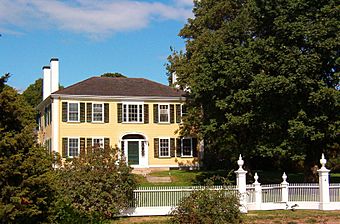King Caesar House facts for kids
Quick facts for kids |
|
|
King Caesar House
|
|
 |
|
| Location | Duxbury, Massachusetts |
|---|---|
| Built | 1809 |
| Architectural style | Federal |
| NRHP reference No. | 78000477 |
| Added to NRHP | March 29, 1978 |
The King Caesar House is a special old house located in Duxbury, Massachusetts. It's at 120 King Caesar Road. Today, it's a museum run by the Duxbury Rural and Historical Society. This group works to preserve history and share it with everyone.
The house was finished in 1809. It was built in the Federal style, which was popular back then. The house was for Ezra Weston II and his wife, Jerusha Bradford Weston. Ezra Weston II was a very successful businessman. People called him "King Caesar" because he was so good at building ships and trading goods. His family business, E. Weston & Sons, was the biggest trading company on the South Shore of Massachusetts in the 1830s and 1840s. A famous U.S. Senator, Daniel Webster, even said in 1841 that Ezra Weston II owned more ships than almost anyone else in the United States!
Contents
A Look at History: The Weston Family
The First "King Caesar"
The Weston family business started with Ezra Weston I, Ezra II's father. He began building small ships like sloops and schooners in Duxbury in 1764. Ezra I also earned the nickname "King Caesar." He was known for being bold and having a lot of influence in local matters.
Ezra Weston II: Expanding the Business
After Ezra I passed away, his son Ezra II took over. He became the new "King Caesar." Ezra II made the business much bigger. He built a large fleet of sailing ships. The Weston name became well-known across the Atlantic Ocean. The company was most successful in the 1820s and 1830s. During this time, Ezra Weston II was the only owner.
The ships built by the Weston company came in many sizes. They ranged from small schooners to huge ships. For example, the ship Hope was launched in 1841. It weighed 880 tons. This was the biggest ship ever built in Duxbury at that time. It was also the largest merchant ship launched in Massachusetts. Ezra Weston II built many schooners for fishing. He also built large ships called brigs for trading all over the world. Over three generations, the Weston company built or bought more than 110 sailing ships.
Life at the King Caesar House
From the King Caesar House, Ezra Weston II managed his entire fleet of ships. He also oversaw a large shipyard, a farm, a rope-making factory, and a sailcloth mill. Many sailors, carpenters, and other workers were employed by him.
After Ezra Weston II died in 1842, his three sons took over the business. They continued to run it until 1857. However, the company's success declined quickly after their father's death. It seems his sons did not have the same business skills as "King Caesar."
The King Caesar House then went to Alden Bradford Weston, Ezra II's second son. After the family business closed, Alden's two brothers quickly spent their family's money. Alden, however, lived a simple life in the King Caesar House. He married later in life but did not have any children. Alden Weston died alone in the house in 1880.
After Alden's death, the house was inherited by King Caesar's grandchildren. Most of them lived in the Boston area. They were not very interested in keeping the large Duxbury mansion.
The House's Later Owners
The Powder Point School for Boys
In 1886, Frederick Bradford Knapp bought the King Caesar House and the land around it. Knapp had worked at Harvard College. He wanted to start a school for boys. He turned King Caesar's old barns into places for sports and classrooms. The school was called the Powder Point School for Boys. It quickly became very well-known. During this time, the King Caesar House was where the headmaster lived with his family. The school ran successfully for almost 40 years. It later joined with Tabor Academy in the 1920s.
Frederick B. Knapp passed away in 1932. By then, the mansion was starting to show its age. His family sold it in 1937 to Dr. Hermon Carey Bumpus, Sr.. Dr. Bumpus was a former director of the American Museum of Natural History in New York. He carefully restored the mansion to its former glory.
Becoming a Museum
In 1945, Miss Alice Moran bought the King Caesar House. She was a lawyer from New York City. She lived there with an Austrian couple, Emil Weber and Elizabeth Weber-Fulop. The servants' living area in the back of the house was turned into an art studio for Elizabeth Weber-Fulop. She was a very respected painter.
Emil and Elizabeth Weber both passed away in the mid-1960s. This left Miss Moran living alone. In 1966, she offered to sell the house to the Duxbury Rural and Historical Society. The community worked together to raise the money needed. They bought and repaired the house. On June 25, 1967, the King Caesar House officially opened as a museum. It was dedicated to remembering Duxbury's busy shipbuilding days.
See also


